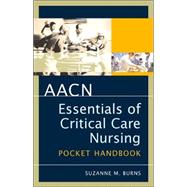
Note: Supplemental materials are not guaranteed with Rental or Used book purchases.
Purchase Benefits
What is included with this book?
Marianne Chulay RN DNSc FAAN is a Consultant, Clinical Research and Critical Care Nursing in Chapel Hill, NC
Suzanne M. Burns, RN, MSN, RRT, ACNP, CCRN, FAAN, FCCM is Professor of Nursing, Acute and Specialty Care at the University of Virginia, Charlottesville, VA
| Preface | xv | ||||
| Section 1. Normal Values | 1 | (6) | |||
|
2 | (5) | |||
| Section 2. Assessment | 7 | (16) | |||
|
8 | (1) | |||
|
9 | (1) | |||
|
10 | (2) | |||
|
12 | (1) | |||
|
13 | (1) | |||
|
14 | (1) | |||
|
15 | (1) | |||
|
16 | (2) | |||
|
18 | (1) | |||
|
19 | (2) | |||
|
21 | (1) | |||
|
21 | (1) | |||
|
22 | (1) | |||
| Section 3. Cardiovascular System | 23 | (102) | |||
|
25 | (2) | |||
|
27 | (2) | |||
|
29 | (1) | |||
|
30 | (1) | |||
|
31 | (1) | |||
|
32 | (1) | |||
|
33 | (1) | |||
|
34 | (2) | |||
|
|||||
|
36 | (1) | |||
|
37 | (1) | |||
|
38 | (25) | |||
|
63 | (1) | |||
|
64 | (1) | |||
|
65 | (1) | |||
|
66 | (1) | |||
|
67 | (1) | |||
|
68 | (1) | |||
|
69 | (1) | |||
|
70 | (2) | |||
|
72 | (1) | |||
|
73 | (1) | |||
|
74 | (1) | |||
|
75 | (2) | |||
|
77 | (1) | |||
|
77 | (1) | |||
|
78 | (2) | |||
|
80 | (2) | |||
|
82 | (2) | |||
|
84 | (2) | |||
|
86 | (2) | |||
|
88 | (2) | |||
|
90 | (2) | |||
|
92 | (2) | |||
|
94 | (2) | |||
|
96 | (2) | |||
|
98 | (2) | |||
|
100 | (1) | |||
|
101 | (1) | |||
|
102 | (1) | |||
|
103 | (1) | |||
|
104 | (2) | |||
|
106 | (1) | |||
|
107 | (1) | |||
|
108 | (1) | |||
|
109 | (1) | |||
|
110 | (6) | |||
|
116 | (3) | |||
|
119 | (4) | |||
|
123 | (1) | |||
|
123 | (1) | |||
|
124 | (1) | |||
| Section 4. Respiratory System | 125 | (32) | |||
|
126 | (1) | |||
|
127 | (1) | |||
|
128 | (1) | |||
|
129 | (1) | |||
|
130 | (1) | |||
|
131 | (2) | |||
|
133 | (1) | |||
|
134 | (23) | |||
| Section 5. Pharmacology Tables | 157 | (44) | |||
|
158 | (26) | |||
|
184 | (3) | |||
|
187 | (3) | |||
|
190 | (6) | |||
|
196 | (3) | |||
|
199 | (2) | |||
| Section 6. Neurologic Concepts | 201 | (6) | |||
|
202 | (1) | |||
|
203 | (2) | |||
|
205 | (1) | |||
|
206 | (1) | |||
| Section 7. Transfer Guidelines | 207 | ||||
|
208 | (1) | |||
|
209 | (1) | |||
|
210 |
The New copy of this book will include any supplemental materials advertised. Please check the title of the book to determine if it should include any access cards, study guides, lab manuals, CDs, etc.
The Used, Rental and eBook copies of this book are not guaranteed to include any supplemental materials. Typically, only the book itself is included. This is true even if the title states it includes any access cards, study guides, lab manuals, CDs, etc.